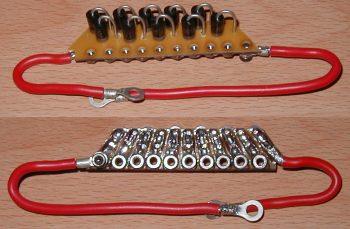
|
Diode Commutation Experiments Diode Commutation - Plain silicon rectifier diodes provide a simple means of clamping the inductive voltage which appears across the terminals of the switching device as it turns off. However, the use of a single commutating diode leads to an exponential type RL current decay which has been shown to interact with the projectile as it exits the coil - the current is 'boosted' at the expense of projectile kinetic energy. This interaction retards the projectile so the question arises, how can this effect be reduced? Collapsing this current more quickly should lessen it's effect on the projectile. The time constant of the current decay can be reduced by increasing the resistance of the commutating circuit. Another possibility is to connect several diodes in series thereby increasing the conduction voltage and the subsequent decay rate. Using a series arrangement of several diodes results in a pseudo-linear current decay. This is due to the threshold voltage of the diodes - consider the following equation:
If each diode demands an induced voltage of e in order to conduct then as long as energy is available in the field the current will decay at a rate of:
where n is the number of series diodes. The actual decay isn't purely linear due to the exponential behaviour of the diode forward conduction. A more thorough analysis will be added to the theory section as time permits. This series of experiments explores the effect of multiple series commutating diodes. In order to quickly connect several different numbers of diodes together I constructed a simple diode array which can be configured to give 1-10 diodes in series. The diodes are 1N5401 silicon rectifier diodes with a pulsed current rating of 200A (8ms duration). Fig 1 shows the array.
Fig 1. 10 segment diode array. Results:
|
|




